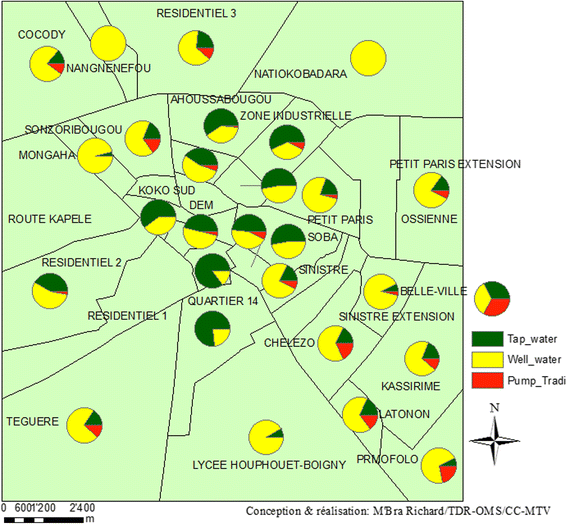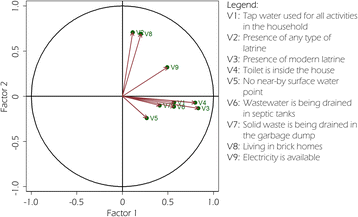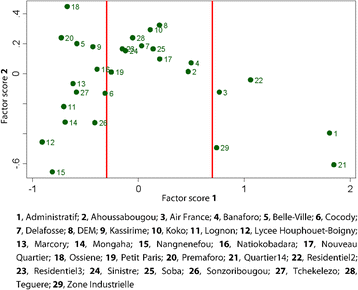Risk factors for schistosomiasis in an urban area in northern Côte d'Ivoire
- PMID: 29773076
- PMCID: PMC5958400
- DOI: 10.1186/s40249-018-0431-6
Risk factors for schistosomiasis in an urban area in northern Côte d'Ivoire
Abstract
Background: Schistosomiasis is a water-based disease transmitted by trematodes belonging to the genus Schistosoma. The aim of this study was to assess the relationship between the prevalence of schistosomiasis and access to water, sanitation and hygiene (WASH) and environmental and socioeconomic factors in the city of Korhogo, northern Côte d'Ivoire.
Methods: A cross-sectional study including 728 randomly selected households was conducted in Korhogo in March 2015. The heads of the households were interviewed about access to WASH and environmental and socioeconomic factors. All children abed between 5 and 15 years living in the households were selected to provide stool and urine samples for parasitological diagnosis of Schistosoma mansoni and Schistosoma haematobium infection. The relationship between infection with S. mansoni and potential risk factors was analysed by a mixed logistic regression model with 'household' as a random factor. Likelihood ratio tests were used to identify factors that were significantly associated with a Schistosoma spp. infection.
Results: The overall prevalence of schistosomiasis among school-aged children in Korhogo was 1.9% (45/2341) composed of 0.3% (3/1248) S. haematobium and 3.5% (42/1202) S. mansoni. Due to the low prevalence of S. haematobium infection, risk factor analysis was limited to S. mansoni. Boys were 7.8 times more likely to be infected with S. mansoni than girls. Children between 10 and 15 years of age were 3.8 times more likely to be infected than their younger counterparts aged 5-10 years. Moreover, living in a house further away from a water access point (odds ratio [OR] = 0.29, 95% confidence interval [CI]: 0.13-0.70) and abstaining from swimming in open freshwater bodies (OR = 0.16, 95% CI: 0.04-0.56) were significantly associated with decreased odds of S. mansoni infection. The socioeconomic status did not appear to influence the prevalence of S. mansoni.
Conclusions: A strategy to reduce the incidence of schistosomiasis should focus on health education to change the behaviour of populations at risk and encourage communities to improve sanitation and infrastructure in order to reduce contact with surface water.
Keywords: Côte d’Ivoire; Schistosomiasis; School-aged children; Urban agriculture; Vulnerability index; Water, Sanitation and Hygiene (WASH).
Conflict of interest statement
Ethics approval and consent to participate
This research was carried out in the frame of a project entitled ‘Vulnerability and resilience to malaria and schistosomiasis in the northern and southern fringes of the sahelian belt in the context of climate change’ funded by TDR/WHO and implemented from 2013 to 2017 in Côte d’Ivoire and Mauritania. In Côte d’Ivoire, the National Ethics Committee cleared the research protocol (reference no. 10056/MSHP/CNER-dkn, dated 29 May 2013). Informed consent was obtained from parents (or legal guardians) before collection of samples of their school-aged children. Participation was voluntary, and hence, parents or children could withdraw anytime without further obligation. With the collaboration of the schistosomiasis control programme and the medical district officer, we treated child infected with
Competing interests
The authors declare that they have no competing interests.
Figures






Similar articles
-
Characteristics of persistent hotspots of Schistosoma mansoni in western Côte d'Ivoire.Parasit Vectors. 2020 Jul 2;13(1):337. doi: 10.1186/s13071-020-04188-x. Parasit Vectors. 2020. PMID: 32616074 Free PMC article.
-
Potential associations between Schistosoma mansoni infection and physico-chemical characteristics and water-related human activities in Côte d'Ivoire: a cross-sectional study.Parasit Vectors. 2024 Oct 8;17(1):422. doi: 10.1186/s13071-024-06466-4. Parasit Vectors. 2024. PMID: 39380000 Free PMC article.
-
Bayesian risk mapping and model-based estimation of Schistosoma haematobium-Schistosoma mansoni co-distribution in Côte d'Ivoire.PLoS Negl Trop Dis. 2014 Dec 18;8(12):e3407. doi: 10.1371/journal.pntd.0003407. eCollection 2014 Dec. PLoS Negl Trop Dis. 2014. PMID: 25522007 Free PMC article.
-
Gender-related differences in prevalence, intensity and associated risk factors of Schistosoma infections in Africa: A systematic review and meta-analysis.PLoS Negl Trop Dis. 2021 Nov 17;15(11):e0009083. doi: 10.1371/journal.pntd.0009083. eCollection 2021 Nov. PLoS Negl Trop Dis. 2021. PMID: 34788280 Free PMC article.
-
Analysis of the dynamics of transmission of human schistosomiasis in the highveld region of Zimbabwe. A review.Trop Med Parasitol. 1988 Sep;39(3):187-93. Trop Med Parasitol. 1988. PMID: 3143147 Review.
Cited by
-
The epidemiological status of urogenital schistosomiasis among reproductive aged individuals in the Tiko Health Area- a semi-urban setting in the Mount Cameroon area.PLoS Negl Trop Dis. 2021 Jan 11;15(1):e0008978. doi: 10.1371/journal.pntd.0008978. eCollection 2021 Jan. PLoS Negl Trop Dis. 2021. PMID: 33428614 Free PMC article.
-
Risk Factors and Spatial Distribution of Schistosoma mansoni Infection among Preschool-Aged Children in Blapleu, Biankouma District, Western Côte d'Ivoire.J Trop Med. 2021 Nov 28;2021:6224401. doi: 10.1155/2021/6224401. eCollection 2021. J Trop Med. 2021. PMID: 34876909 Free PMC article.
-
Discovering new pathways toward integration between health and sustainable development goals with natural language processing and network science.Global Health. 2023 Jun 29;19(1):44. doi: 10.1186/s12992-023-00943-8. Global Health. 2023. PMID: 37386579 Free PMC article.
-
Prevalence and Risk Factors for Schistosomiasis among Schoolchildren in two Settings of Côte d'Ivoire.Trop Med Infect Dis. 2019 Jul 23;4(3):110. doi: 10.3390/tropicalmed4030110. Trop Med Infect Dis. 2019. PMID: 31340504 Free PMC article.
-
High prevalence of Schistosoma haematobium × Schistosoma bovis hybrids in schoolchildren in Côte d'Ivoire.Parasitology. 2020 Mar;147(3):287-294. doi: 10.1017/S0031182019001549. Epub 2019 Nov 21. Parasitology. 2020. PMID: 31727202 Free PMC article.
References
-
- Sturrock RF. The intermediate hosts and host-parasite relationships. In: Jordan P, Webbe G, Sturrock RF, editors. Human schistosomiasis. Wallingford: CAB International; 1993. pp. 33–85.
-
- Cecchi P, Baldé S, Yapi YG. Mollusques hôtes intermédiaires. In: Cecchi P, Lévêque C, Aubertin C, editors. L’eau en partage: Les petits barrages de Côte d’Ivoire. Paris: IRD; 2007. p. 175–89. (in French).
MeSH terms
Substances
Grants and funding
LinkOut - more resources
Full Text Sources
Other Literature Sources
Medical
Miscellaneous

